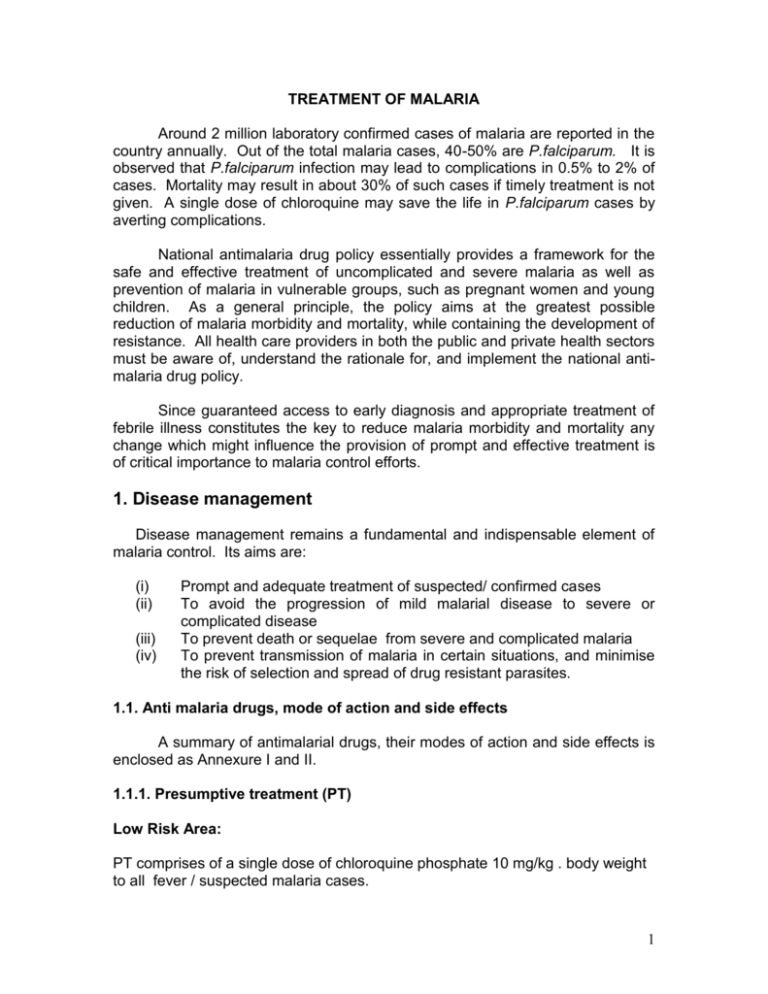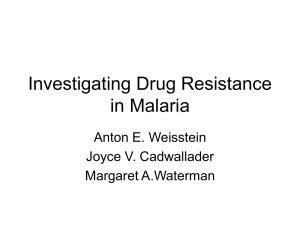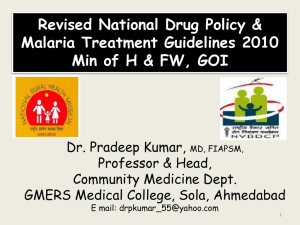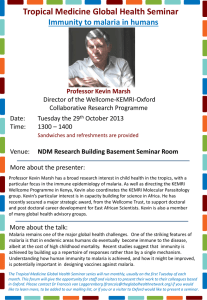TREATMENT OF MALARIA
advertisement

TREATMENT OF MALARIA Around 2 million laboratory confirmed cases of malaria are reported in the country annually. Out of the total malaria cases, 40-50% are P.falciparum. It is observed that P.falciparum infection may lead to complications in 0.5% to 2% of cases. Mortality may result in about 30% of such cases if timely treatment is not given. A single dose of chloroquine may save the life in P.falciparum cases by averting complications. National antimalaria drug policy essentially provides a framework for the safe and effective treatment of uncomplicated and severe malaria as well as prevention of malaria in vulnerable groups, such as pregnant women and young children. As a general principle, the policy aims at the greatest possible reduction of malaria morbidity and mortality, while containing the development of resistance. All health care providers in both the public and private health sectors must be aware of, understand the rationale for, and implement the national antimalaria drug policy. Since guaranteed access to early diagnosis and appropriate treatment of febrile illness constitutes the key to reduce malaria morbidity and mortality any change which might influence the provision of prompt and effective treatment is of critical importance to malaria control efforts. 1. Disease management Disease management remains a fundamental and indispensable element of malaria control. Its aims are: (i) (ii) (iii) (iv) Prompt and adequate treatment of suspected/ confirmed cases To avoid the progression of mild malarial disease to severe or complicated disease To prevent death or sequelae from severe and complicated malaria To prevent transmission of malaria in certain situations, and minimise the risk of selection and spread of drug resistant parasites. 1.1. Anti malaria drugs, mode of action and side effects A summary of antimalarial drugs, their modes of action and side effects is enclosed as Annexure I and II. 1.1.1. Presumptive treatment (PT) Low Risk Area: PT comprises of a single dose of chloroquine phosphate 10 mg/kg . body weight to all fever / suspected malaria cases. 1 Age in Year Çhloroquine Phosphate Mg. Base No. of Tablets (150 mg) 75 ½ 150 1 300 2 450 3 600 4 <1 1-4 5-8 9-14 15 & above High Risk area: As per revised policy of NVBDCP presumptive treatment of all suspected malaria cases, up to sub-centre level only, in “high risk areas”(as defined in the MAP 95), is as follows: Chloroquine Base Primaquine Chloroquine base Chloroquine base Day 1 Day 1 Day 2 Day 3 10 mg/kg 0.75 mg/kg 10 mg/ kg 5 mg/kg (600 mg adult) (45 mg adult) (600 mg adult) (300 mg adult) Dosage as per age groups Age in years <1 1-4 5-8 8-14 >14 Day 1 Tab Chloroquine (150 mg base) ½ 1 2 3 4 Day 2 Primaquine (7.5 mg) 0 1 2 4 6 Tab Chloroquine (150 mg base) ½ 1 2 3 4 Day 3 Tab Chloroquine (150 mg base) ¼ ½ 1 1½ 2 1.1.2. Radical Treatment: Low Risk Area Plasmodium vivax Age in year <1 Chloqouine Phosphate 150 mg base Single dose Mg base No. of tablets 75 1/2 Primaquine 2.5 mg base Daily dose for 5 days Mg base No. of tablets Nil Nil 2 1-4 5-8 9-14 15 & above 150 300 450 600 1 2 3 4 2.5 5.0 10.0 15.0 1 2 4 6 Plasmodium falciparum In “Low Risk Areas” where presumptive treatment with 600 mg chloroquine alone (adult dose) has been given and later blood smear is found positive for Pf, the complete radical treatment should be given with a single dose of tablet chloroquine 10 mg/kg bw combined with 0.75 mg/kg bw of primaquine. High Risk Area Plasmodium vivax In high risk areas where presumptive treatment with 1500 mg chloroquine base spread over three days and 45 mg primaquine (adult dose) has been given, chloroquine need not be administered again, but primaquine must be given for 5 days. Age in year <1 1-4 5-8 9-14 15 & above Tablets Primaquine 2.5 mg base Daily dose for 5 days Mg base No. of tablets Nil Nil 2.5 1 5.0 2 10.0 4 15.0 6 Plasmodium falciparum In “High Risk Areas”, fever cases are given presumptive treatment with 1500 mg Chloroquine (over 3 days) and 45 mg Primaquine (adult single dose). Therefore radical treatment with primaquine is not required if they are found positive for Pf microscopically. 1.1.3. Chloroquine resistant P.falciparum case The radical treatment of Pf cases in chloroquine resistant areas, which are under alternate drug schedule, and in specific cases not responding to chloroquine, is by second line of treatment. Resistance should be suspected if in spite of full treatment and no history of vomiting, diarrhoea, patient does not respond within 72 hours parasitologically or deteriorate clinically. National Anti Malaria Drug Policy has recently recommended Artesunate + sulfadoxine/ 3 sulfalene combination therapy (SP –ACT) in confirmed chloroquine resistant cases. This must be followed with Primaquine (45 mg). The age-wise dosage is as follows: Age in year <1 1-4 5-8 9-14 15 & above Artesunate (AS) Sulfadoxine+ pyrimethamine (SP) AS SP AS SP AS SP AS SP AS SP I day (no. of tablets) II day (no. of tablets) III day (no. of tablets) ½ ¼ 1 1 2 1½ 3 2 4 3 ½ Nil 1 NIl 2 Nil 3 Nil 4 Nil ½ Nil 1 NIl 2 Nil 3 Nil 4 Nil Dose of Artesunate is 4 mg /kg body weight for 3 days. Strength of the tablet is 50 mg. Dose of SP is 25 mg /kg body weight of sulfadoxine plus 1.25 mg /kg body weight of pyrimethamine single dose. The strength of SP tablet is 500 mg sulfadoxine and 25 mg of pyrimethamine. Note: Sulfalene/Sulphadoxine and Pyrimethamine combination does not take care of P.vivax cases. Where SP -ACT is not available, SP alone should be given. 2. Additional aspects of management of malaria: 2.1. Treatment of uncomplicated malaria: Clinical Presentation: Malaria presents with marked clinical heterogeneity. Presentation may vary from patients with asymptomatic parasitaemia in the blood to severe and fatal illness. Host immunity and parasitic variations are two major determinants of malarial presentation. Following are clinical presentations of uncomplicated malaria. Typical: Sudden onset of high fever with rigors and sensation of extreme cold followed by feeling of burning, leading to profuse sweating and remission of fever by crisis thereafter. The febrile paroxsyms occur every alternate day. Headache, body ache, nausea, etc. may be associated features. 4 Atypical: In atypical cases, classical presentation as mentioned above may not manifest. Hence, any fever case until unless proved otherwise, may be considered as malaria in the endemic areas during transmission season. In most of the cases the first symptoms are non-specific and similar to those of a minor viral illness with malaise, headache, fatigue, abdominal discomfort and muscle aches followed by fever and chills. Repeated infections lead to anaemia, enlargement of spleen and chronic ill health with bouts of fever. Most patients with uncomplicated acute infection have few abnormal physical findings other than mild anaemia and in some cases a palpable spleen. None of the clinical features of malaria is pathognomonic. With appropriate treatment outcome in uncomplicated malaria is excellent. The factors to be taken into account in treatment of uncomplicated malaria cases are: (i) drug effectiveness is determined mainly by efficacy, patient compliance and drug quality (ii) drug side effects, tolerance, cost, affordability, availability and acceptability to the community and service providers (iii) health care seeking pattern (iv) characteristic of health services The management of uncomplicated malaria involves patients, carers, health care staff, drug vendors including pharmacists and drug suppliers. The management of malaria disease includes: recognition of signs and symptoms of the patient; diagnosis of malaria disease and/ or other febrile conditions; referral to higher level of care, if necessary; education of patient or family on : (i) how to take or administer the drugs (ii) when to return to health facility (iii) danger signs (iv) prevention of malaria dispensing or selling the correct drugs of assured quality, with the first dose always being taken under supervision; patient compliance with prescription instructions; follow-up to check whether the expected therapeutic efficacy has been achieved. The crucial concern is the timeliness of correct treatment with the correct drug. A mild facliparum malaria case can progress to severe disease in a few hours, especially in children. Effective treatment for the disease must be available close to the home and must be complete. 5 2.2. Management of severe and complicated malaria at the periphery The priority requirement is the early recognition of signs and symptoms of severe malaria that should lead to emergency care in in-patient settings. The signs and symptoms that can be used are non-specific and may be due to severe febrile disease, which may be severe malaria, another severe febrile disease or concomitant malaria and severe bacterial infection. Children: The signs and symptoms in children are a history of high fever, plus at least one of the following :(i) (ii) (iii) (iv) (v) prostration (inability to sit), altered consciousness lethargy or coma; breathing difficulties; severe anaemia; convulsions; inability to drink/ vomiting Patients with prostration and/or breathing difficulties should, if at all possible, be treated with parenteral antimalarials and antibiotics. If the clinical condition permits, other patients may be treated with oral antimalarials. Adults: The same symptoms and signs in children are valid for adults, with addition of : dark and/ or limited production of urine Table 1: Differences between presentation of severe malaria in adults and in children Sign or symptoms Anaemia Convulsions Pre-treatment hypoglycaemia Metabolic acidosis History of cough Jaundice Renal failure Pulmonary oedema, ARDS Duration of illness Resolution of coma Adults Common Common Less common Less common Uncommon Very common Common Less common Longer (5-7 days) Longer (2-4 days) Children Very common Very common Common Common Common Common Less common Rare Shorter (1-2 days) Shorter (1-2 days) For settings where patients with severe malaria present regularly and it is not possible to refer them rapidly to facilities, a basic package for initial treatment could be made available, supported by training and supervision. The training of medical and paramedical professionals should emphasize that, if at all possible, patients who have improved after initial treatment, but are ill, should be referred. 6 The contents of basic package for management of severe malaria at PHCs/ CHCs in malaria endemic areas should include: (i) (i) (ii) (iii) (iv) a parenteral antimalarial a parenteral antibiotic an effective oral antimalarial a rectal anticonvulsant intravenous fluid Severe malaria is the serious and life-threatening form of falciparum malaria, which needs urgent and intensive patient care. Therefore, early recognition of the signs and symptoms of severe malaria helps in emergency care and reduction of malaria related mortality. Unfortunately, the signs and symptoms are non-specific and are present in most other severe febrile diseases commonly seen in malarious areas. Some of the important diseases, having similar presentation as severe malaria are meningitis, encephalitis, septicaemia, typhoid fever, leptospirosis, viral infections, etc. Therefore confirmation by microscopy / immunological tests is desirable and adds strength to the diagnosis. Who is at risk for severe complications? In areas of low transmission – all age groups are vulnerable but adults develop more severe and multiple complications. The transmission pattern in most parts of India is usually low, but intense transmission is seen in north-eastern states and large areas of Orissa, Chattisgarh, Jharkhand, and Madhya Pradesh. In areas of high transmission – children below 5 years, visitors, migratory labours. Association of pregnancy Treatment of severe and complicated malaria: Semiconscious or comatose patients of severe P.falciparum infection should be treated with Quinine. It is the drug of choice also for pregnant women and infants. a. Quinine I.V. 10mg/kg body wt. (600 mg.) 8 hourly, (total 24 hour intake should not exceed 1.8 gms in an adult) till the patient regains consciousness and is able to take drugs orally. Oral Quinine 600 mg TDS is to be continued for seven to ten days. When adequate facilities for management of complications arising out of Quinine toxicity are available a loading dose of Quinine dihydrochloride 20 mg per kg body weight as infusion is given, and it should be well diluted with 500 ml. Of 5 per cent glucose. Infusion is given over a period of 5 hours (2 ml per minute). If no I.V. facility is available, deep intramuscular dose of 10 mg per kg body wt. is given 8 hourly. I.M. injections produce complications which, sometimes in the long run, are crippling if proper precautions are not taken. 7 b. Injection Arteether: It is available in 2 ml ampoules containing 150 mg. The recommended regime is 150 mg /day once daily by intramuscular route for three days for adults. The dosage for children is 3 mg/kg per day IM for three days. c. Chloroquine injection: Chloroquine is not well tolerated specially by infants or young children. In a patient of any age it may produce low blood pressure, sudden collapse with high mortality. Parenteral administration of Chloroquine is more hazardous than parenteral administration of quinine. It should be used only when Quinine or arteether injections are not available. It is given in doses of 3.5 mg/kg body wt 8 hourly slowly in isotonic fluid. Total 24 hour dose should not exceed 600 mg base (up to 10 mg/kg body weight). Dose of Chloroquine I.M. is 5 mg per kg body wt. Management of other signs & symptoms I. Hyperpyrexia (Rectal Temperature above 39oC) a. b. c. d. Tepid sponging If the temperature is 39oC or above, remove patient’s clothes and cover him with towel or sheet soaked in tepid water and keep him under the fan. Keep patient in an air-conditioned room, if possible. Paracetamol: 5 mg kg/body wt parenteral administration if required. II. Dehydration Glucose saline I.V., measure urine output, maintain slightly negative fluid balance and avoid pulmonary complications II. Acute renal failure with anuria or oliguria and black water fever It must be managed with proper biochemical examination of blood, serum electrolytes and E.C.G. etc. a. Dextran with glucose saline I.V. to correct dehydration – If this fails to induce urine secretion and output remains less than 60 cc per hour, give b. Furosemide 20 mg or as required, upto 500 mg I.V. or I.M. as considered appropriate c. Constantly keep watch on urinary output 8 d. If no improvement, dialysis. It should not be delayed and treating physician may take quick decision. It may require haemodialysis or peritoneal dialysis. e. Keep watch on serum creatinine, blood urea and serum potassium levels f. Alkalinise the urine if there is haemoglobinuria g. Maintain diet control and restrict protein intake to 20 to 30 gms. per day. III. Hyperkalaemia : Cardiac arrythmia and cardiac arrest may occur when serum potassium is 7 mol and above. Calcium charged resin (calzeocarb 225) 15 –30 g orally 3-4 tmes a day, or 30 g in 100 ml of water rectally, may be given. When the potassium level is over 60 mol, 100 to 200 ml of 84 % sodium bicarbonate may be infused over three hours. Therapy with 20 units of insulin with 50 gm glucose may cause entry of extracellular potassium into the cells. I.V. calcium gluconate 10 to 20 cc may also be given. The safest treatment is haemodialysis. IV. Hypokalaemia : May occur with excessive diuresis after recovery in renal failure. This can be treated with 10 cc potassium chloride in 24 hours or equivalent. V. Pulmonary oedema : Arterial blood gases are monitored if the patient shows evidence of pneumonia, cyanosis or hyperventilation. VI. prop up 45 o give oxygen keep careful watch on fluid balance monitor central venous pressure venesect 250 ml blood into donor bag to be used later on give diuretic. Gastro Intestinal complications : a. I.V. fluids b. For vomiting: Chlorpromazine I.V. or I.M. as required. VII. Bleeding (pulmonary oedema or gastro intestinal complications) :a. Parenteral vit. K, dosage to be regulated depending on patient’s condition b. Fresh whole blood transfusion VIII. Jaundice and Liver damage a. I.V. glucose 9 b. Restrict fats c. Vitamin K and Vitamin B complex supplement d. Bed rest X. Shock a. I.V. Plasma expanders b. Corticosteroids: if condition indicates, use hydrocortisone up to 100 mg 8 hourly c. Dopamine drip XI. Anaemia (PCV< 20, Hb less than 7 gm) - If associated with high parasitaemia a. Whole fresh blood transfusion b. Packed cell transfusion c. After acute condition is controlled, use iron folic acid supplement XII Convulsions Convulsions might occur due to hyperpyrexia, specially in children in both P.vivax and P.falciparum infections a. b. XIII. Hypoglycaemia - XIV. Diazepam (0.2 mg per kg body wt.) I.M./I.V. 8 hourly dosage to be regulated by patient’s response or Phenytoin Sodium 5 mg per kg. body wt. slow I.V. infusion over 15-20 minutes. Prophylactic phenobarbitone 5-10 per kg body wt. I.V. Glucose 50% (up to 1 ml per kg body wt.) Followed by 5-10% I.V drip. Keep constant watch on blood sugar levels. Hyperparasitaemia (Parasitized RBCs 10 % and above) - Exchange transfusion Errors in management of severe falciparum malaria: 1) 2) 3) 4) 5) Misdiagnosis, particularly during epidemics of meningitis and encephalitis Missed microscopic confirmation Missed associated diseases /complications Missed hypoglycaemia Errors of fluid/electrolyte replacement 10 6) Failure to control convulsions 7) Mismanagement of respiratory complications 3. Chemoprophylaxis: 3.1 3.2 Antimalarial In chloroquine sensitive areas chloroquine is to be given In chloroquine resistant areas it is to be supplemented by proguanil Regimen Chemoprophylaxis is to be started a week before arriving at malarious area for visitors. For pregnant women in high risk area prophylaxis should be initiated from second trimester. Start with loading dose of 10 mg/kg bw and followed by a weekly dose of 5 mg/kg bw. This is to continue till 1 month after delivery in case of pregnancy and in travelers till one month after return from endemic area. The terminating dose should be 10 mg/kg bw along with 0.25 mg/kg bw of primaquine for five days. Chemoprophylaxis with chloroquine is not recommended beyond 3 years because of its cumulative toxicity. In chloroquine resistant areas chemoprophylaxis is recommended with chloroquine 5 mg/kg bw weekly and proguanil 100mg daily. References: 1) The clinical management of acute malaria 1990. WHO regional publications, South-East Asia Series No.9 2) Epidemiology and control of malaria in India 1996. R.S. Sharma, G.K. Sharma and G.P.S. Dhillon 3) The use of Antimalarial drugs 2000. WHO/CDS/RBM/2001.33 Report of a informal consultation. 11 Annexure I Classification of the currently used anti-malarials A. aminoquinolines, B. 8- aminoquinolines, C. Arylamino alcohols, D. Methanols i. 4 quinoline methanol ii. 9- phenanthrene methanol E. Biguanides F. Diaminopyrimidines G. Antimalarial endoperoxidases i. First generation endoperoxidases (Artemisinin derivatives) ii. Second generation endoperoxidases a. Trioxanes b. Tetroxanes H. Hydroxynaphthoquinone I. Benzonaphthyridine deriative J. Antibiotics eg. Chloroquine, Hydroxychloroquine, Amodiaquine eg. Primaquine, Tafenoquine, Bulaquine eg. Quinine eg. Mefloquine eg. Halofantrine, Lumefantrine eg. Proguanil eg. Pyrimethamine eg. Artesunate, Artemether, Arteether eg. Atovaquone eg. Pyronaridine eg. Sulfonamides, Tetracycline, Doxycycline, Clindamycin, Azithromycin 12 13 Annexure II NAME Chloroquine MECH. OF ACTION Quinine ? Inhibits plasmodial heme polymerase Toxic drug-heme complex form n Dg. Intercalation of Pl. DNA Intravacuolar pH alteration (Same as Chloroquine) Elimination half life 10 days ACTION 11 hrs. Artesunate / Artemether / Arteether Activated by heme/ molecular iron to produce carbon centered free radicals Membrane damage by free radical < 1 hr. 3-11 hrs > 20 hrs. ADVANTAGE Schizonticidal for all species Gametocidal for Pv. PO.PM. No action on hypnozoites Primary blood schizonticide Little effect on sporozoite Gametocidal to PV and PM Blood schizonticide Gametocidal action recently described DISADVANTAGE Highly potent against sensitive strains Long half life Effective at once a week dose as prophylactic agent Rapid development of resistance not yet seen Rapid development of resistance Higher toxicity Broader window period of effectiveness Little/ no cross resistance Resistance not yet recorded High recrudescenc e rate when used as monotherapy (10-50%) when used for <5 days 14 NAME Mefloquine MECH. OF ACTION Formation of toxic subs. with heme Damages membrane and other comp. Causes swelling of food vacuole T½ 20 days Halofantrine Concentrates and combines with ferri protop orphyrin IX, leading to memb. Damage1 10-90 hrs. Atovaquone Inhibits parasite mitochondrial electron transport chain (complex III )( 70 hrs. Pyronaridine 60 hrs. Inhibits vacuolar degradation, leading tot impaired Hb degradation ACTION Strong schnizontici dal action against all species. Gametocida l l against PV, PM, PO Sporonticida l act Schizonticid al to all species No action on latent tissue form of PV and gametocyte s Blood schizonticid e (used primarily for MDR Pf.)_ Schizonticid e for PF,PV, MDR, PF ADVANTAGE Useful as prophylactic agent for nonimmune travellers Single dose sufficient Good alt. To quinine in MDR Pf. DISADVANTAGE Only oral prep. available. So cannot be used in sev. Pf malaria High chances of crossresistance, might lead to quinine resistance as well Good alternative to mefloquine/ quinine in chloroquine/ MDR Pf. Oral absorption erratic High chances of cross resistance with mefloquine Cardiotoxicity Erratic absorption High recrudescence rate when used alone Good oral absorption Cross resistance not yet documented Well tolerated 15 NAME Sulfadoxine Pyrimethamine MECH. OF ACTION Acts against the parasite dihydrofolate reductase enzyme Primaquine May get converted to electrophiles that act as redox mediators Proguanil Selective inhibition of the bi-functional dihydrofolate reductase-thymidylate synthetase of Pl. T½ ACTION ADVANTAGE Sulfadoxine Active against Can be used – 180 hrs. blood schizonts of against Pyrimethami P.falciparum. chloroquine ne – 95 hrs Less active resistant against other P.falciparum. species No cross resistance with the 4 aminoquinoline s, mefloquine, quinine, artemisinin derivatives 6 hrs. Destroys late Useful for the hepatic stage and terminal latent forms of PV prophylaxis and and PO radical cure of PV and PO Gametocidal to all sp., mainly Pf. No action on erythrocyte stage of Pf., though active against the hepatic stage 16 hrs. Weak Good schizonticidal prophylactic action against all agent for Pf or species. mixed infection, when used with chloroquine DISADVANTAGE Risk of severe skin reactions Cannot be used in patient with G-6PD deficiency. Can not be used alone in treatment of malaria 16 17







